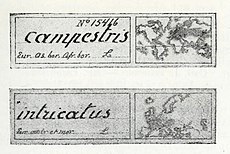The Zoologist/4th series, vol 1 (1897)/Issue 668/Museum Reports-I: Musée Royal d'Histoire Naturelle de Belgique: Brussels
MUSEUM REPORTS.— I.
MUSEÉ ROYAL D'HISTOIRE NATURELLE DE BELGIQUE:
BRUSSELS.
By G. Severin, Aide-naturaliste au Musée.
I am unable to report as to the whole of our zoological collections. At a standstill, except in the palæontologieal series, our Museum has not advanced for some years, except in Entomology, of which I will gladly speak. My aim on my arrival at the Museum was above all things to have a collection useful to everybody, and it will perhaps be of some interest to state how I worked for that purpose, and with what result.
It must be remembered that I have been at the Museum only six years, but these have proved to me that collections, even the most important, can in a short time be brought to complete order. Above everything I have abandoned all idea of specialising a group or family of insects. I am interested as much in Coleoptera as in Hemiptera, or in Crustacea as in Arachnida. I determine nothing myself, except any well-known species of which I know the name, and of which there can be no doubt. All our entomological collections are determined by distinguished specialists, and I prefer to await the offer of assistance rather than to solicit it. When the insects are determined each receives a label with the name of the verifier and the year when verified, and a number is attached to the species repeated with all specimens, corresponding to the name given by the specialist, which name is written in a register-catalogue. If a second specialist should study the same insect his identification is indicated on another label without any change of number if his verification should agree with the former one. A new number below the former number indicates a divergence of opinion between the specialists. After a certain time the insects so studied will have a great scientific value and the collection a strikingly typical status. This system is completed by a locality-label at the bottom of the case, after the following model, which will explain to you our method.
My collections are divided into series:—1st. "The General Collection," to which the foregoing labels apply, and is arranged so as to exhibit seventy-five per cent. of the species actually described.
2nd. "The Belgian Collection," which contains the labels of all the species which may be met with in Belgium.
There is also a catalogue, followed by large maps of the country, and containing all the notes and descriptions which we have of our insects. There are about 14,000 cards.
3rd. The Congo Collection, in process of formation, and which I will refer to further on.
All these collections are found under three forms:—1st, The Collection; 2nd, Supplements; 3rd, Duplicates. All which we receive are immediately placed among the "Supplements," and when a sufficient number are obtained their study is commenced.
It will be seen that the system is simple, and allows a very rapid arrangement of any collection, no matter how important. Thus it has been possible for me to arrange in less than six years about 125,000 species and 700,000 specimens, with further 700,000 duplicates, the whole arranged in 6000 glass cases. These are not all determined, but at least arranged and set in order; for I still await some specialist to occupy himself with some of the genera. It must be pointed out, however, that though I say the arrangement has been carried out in six years, the classification to a great extent was commenced fifteen years before I came to the Museum.
I have suppressed all conventional colour in my collections, the geographical indications employed from the beginning in our Museum being quite sufficient. It remains for me to speak now of our additions during the last few years.
Our collection of Coleoptera has been always very rich. I do not enumerate those obtained in our neighbourhood or the result of small purchases.
- Carabidæ. Coll. Putzeys.
- Dytiscidæ. Colls. Chevrolat, Severin.
- Staphylinidæ. Coll. Germain. (European.—These are the insects which have been used by Fauvel in his 'Faune Gallo rhénane'). Coll. Fairmaire (Exotiques).
- Coprophagi. Coll. J. Thomson.—Coll. Lafontaine.
- Melolonthinæ, Anomalinæ, Rutelinæ. Coll. J. Thomson.—Coll. Lafontaine.
- Buprestidæ. Coll. Weyers.
- Lycinæ, Lampyrinæ. Coll. Guerin Méneville.
- Heteromera. Coll. J. Thomson.
- Curculionidæ. Coll. Dejean, Lacordaire, Racine, Castelnau, Gobert.
- Anthribidæ et Brenthidæ. Coll. ditto, ditto.
- Scolytidæ. Coll. Chapuis.
- Longicornia. Coll. Lacordaire.
- Chrysomelidæ. Coll. Chapuis, Castelnau, Semper, Duvivier.
- Hymenoptera. Les coll. Wesmael.
- Hemiptera. Coll. Van Volxem.
- Lepidoptera. Coll. (Palæarctic) Wienmann, Breyer, Defré, Thysebaert.
The principal additions during the last four years have been the insects from the Congo. We have bought the Duvivier Collection, so that our African collection will be the richest, if it is not so already.
Jan. 23rd, 1897.
![]()
This work is in the public domain in the United States because it was published before January 1, 1929.
The longest-living author of this work died in 1936, so this work is in the public domain in countries and areas where the copyright term is the author's life plus 87 years or less. This work may be in the public domain in countries and areas with longer native copyright terms that apply the rule of the shorter term to foreign works.
![]()
Public domainPublic domainfalsefalse

